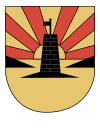Brønnøysund
| Brønnøysund | |
|---|---|
| Town | |
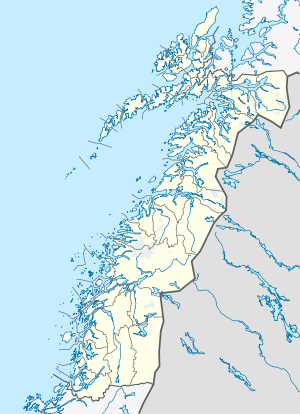 Brønnøysund Location in Nordland | |
| Coordinates: 65°28′30″N 12°12′43″E / 65.47500°N 12.21194°ECoordinates: 65°28′30″N 12°12′43″E / 65.47500°N 12.21194°E | |
| Country | Norway |
| Region | Northern Norway |
| County | Nordland |
| District | Helgeland |
| Municipality | Brønnøy |
| Area[1] | |
| • Total | 3.25 km2 (1.25 sq mi) |
| Elevation[2] | 4 m (13 ft) |
| Population (2013)[1] | |
| • Total | 4,924 |
| • Density | 1,515/km2 (3,920/sq mi) |
| Time zone | CET (UTC+01:00) |
| • Summer (DST) | CEST (UTC+02:00) |
| Post Code | 8900 Brønnøysund |
| Brønnøysund ladested | ||
|---|---|---|
| Former Municipality | ||
| ||
| Municipality ID | NO-1801 | |
| Adm. Center | Brønnøysund | |
| Created from | Brønnøy in 1923 | |
| Merged into | Brønnøy in 1964 | |
Brønnøysund (Norwegian: [ˈbrœnnœʏˈsʉn] (![]() listen))[3] is a town and the administrative centre of the municipality of Brønnøy, Norway. It is also a former municipality in Nordland county. The village of Brønnøysund received town status in 2000. The city lies along the coast and is often called "the coastal town in the middle of Norway." Brønnøysund is also the regional center of Southern Helgeland. The 3.25-square-kilometre (800-acre) town has a population (2013) of 4,924; giving the town a population density of 1,515 inhabitants per square kilometre (3,920/sq mi).[1]
listen))[3] is a town and the administrative centre of the municipality of Brønnøy, Norway. It is also a former municipality in Nordland county. The village of Brønnøysund received town status in 2000. The city lies along the coast and is often called "the coastal town in the middle of Norway." Brønnøysund is also the regional center of Southern Helgeland. The 3.25-square-kilometre (800-acre) town has a population (2013) of 4,924; giving the town a population density of 1,515 inhabitants per square kilometre (3,920/sq mi).[1]
History
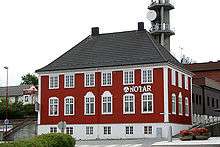
Brønnøysund was established as a municipality on 1 January 1923 when it was separated from the municipality of Brønnøy to become a town (ladested) and municipality of its own. On 1 January 1964, Brønnøysund was merged with the neighbouring municipalities of Brønnøy, Sømna, Velfjord, and part of Bindal to form a new, larger municipality of Brønnøy. At that time, it lost its town status until 2000 when they were once again granted.[4]
During the Viking era, Torgar, by the foot of the legendary mountain Torghatten, was a nationally powerful chieftain seat and an important commercial center along the coast. The original inhabitants were wiped out in an outright massacre by Duke Skule and his men in the Norwegian civil wars that raged around 1240, in the high medieval era of Norway.
The region was re-populated by immigrants from Southern Norway, Trøndelag, and Sweden, which could explain the unique dialect with a Swedish-like intonation.
In May 1945 "the prisoners [foreign POWs] from Ylvingen"[5] were transported by ship from the harbor at Brønnøysund.[5] ("the song saved my life") documents the farewell to Igor Trapitsin and the other Soviet ex-POWs from the harbour at Brønnøysund.[6]
Economy
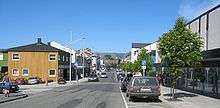
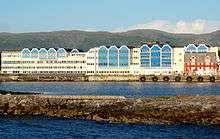

The 3.55-square-kilometre (1.37 sq mi) town of Brønnøysund has a population (2013) of 4,625 and a population density of 1,303 inhabitants per square kilometre (3,370/sq mi).[1] It is also the administrative and commercial centre of the municipality of Brønnøy.
In recent years, Brønnøysund has managed to create a certain economic growth. Fjord Seafood originated here, as well as the largest limestone mine in Northern Europe and the highest foodstuff production in Northern Norway are examples of entrepreneurship and well-run economy in this somewhat prosperous region. Modern agriculture, hydroponics, the large TTS transport corporation, wood-processing and tourism are the main driving industries.
Transportation
Brønnøysund has daily visits by the Hurtigruten (Coastal Express), northbound at night and southbound in the afternoon. It has its own airport, Brønnøysund Airport, Brønnøy, and a direct eastbound connection to the European route E6 highway.
Throughout Norway, the town is known as the location of the Brønnøysund Register Centre, in which the new e-government portal Altinn is the newest addition. Torghatten ASA has its headquarters in Brønnøysund.
Airport
Brønnøysund Airport, Brønnøy is located only about 2 kilometres (1.2 mi) from the town centre, and is a vital communications link not only for the town, but also for a large region surrounding the town.
The airport opened in 1968, providing modern and much needed, time-effective transportation to the region, and making it possible to reach both the capital and medical services within an acceptable timeframe.
In May 2010, the direct flight to Oslo was launched, and since April 2011 there are three daily departures for Oslo with a 50-seat plane.[7] There are also connections to Sandnessjøen, Mo i Rana, Rørvik, Trondheim, and Bodø.[8]
It is served by Norway's oldest airline, Widerøe. It is also base for some of the offshore helicopter services, making it possible to exploit the vast petroleum resources offshore.
Culture
The town has a number of cultural institutions:
- Brønnøysund Musikkorps (wind band)
- Brønnøysund Mannskor (male choir)
- Kor i Øyan (mixed choir)
The NRK series Himmelblå, a franchise of the British Two Thousand Acres of Sky, was filmed in part in Brønnøysund and on various locations nearby. The local Brønnøy Church serves the town of Brønnøysund.
Geography

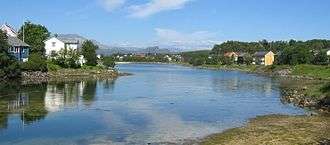
Brønnøysund sits on a narrow peninsula on the mainland surrounded by islands and water. The town is connected to the island Torget by the Brønnøysund Bridge.
Climate
Brønnøysund has a subpolar maritime climate with mild winters (Koppen Cfc) considering the northerly location, and a long frost-free season of typically 160 – 180 days.[9] Mean annual temperature is 5.6 °C (42 °F) and average annual precipitation 1,510 mm.[10] Daytime temperatures are usually warmer than the 24hr average from March to October. The data in the table is based on a 1961 - 1990 average. Recent years have tended to be warmer.
| Climate data for Brønnøysund | |||||||||||||
|---|---|---|---|---|---|---|---|---|---|---|---|---|---|
| Month | Jan | Feb | Mar | Apr | May | Jun | Jul | Aug | Sep | Oct | Nov | Dec | Year |
| Daily mean °C (°F) | −1.1 (30) |
−0.6 (30.9) |
0.9 (33.6) |
3.7 (38.7) |
8.4 (47.1) |
11.2 (52.2) |
13.1 (55.6) |
13.0 (55.4) |
9.8 (49.6) |
6.6 (43.9) |
2.2 (36) |
−0.1 (31.8) |
5.6 (42.1) |
| Average precipitation mm (inches) | 138 (5.43) |
102 (4.02) |
114 (4.49) |
97 (3.82) |
66 (2.6) |
83 (3.27) |
123 (4.84) |
113 (4.45) |
180 (7.09) |
192 (7.56) |
145 (5.71) |
157 (6.18) |
1,510 (59.45) |
| Source: Meteorologisk Institutt[11] | |||||||||||||
In popular culture
- The 2015 documentary film Sangen reddet mitt liv[5] ("the song saved my life") documents the farewell to Igor Trapitsin and the other Soviet ex-POWs from the harbour at Brønnøysund.[6]
References
- 1 2 3 4 Statistisk sentralbyrå (1 January 2013). "Urban settlements. Population and area, by municipality.".
- ↑ "Brønnøysund" (in Norwegian). yr.no. Retrieved 2011-11-07.
- ↑ Berulfsen, Bjarne (1969). Norsk Uttaleordbok (in Norwegian). Oslo: H. Aschehoug & Co (W Nygaard). p. 54.
- ↑ Jukvam, Dag (1999). "Historisk oversikt over endringer i kommune- og fylkesinndelingen" (PDF) (in Norwegian). Statistisk sentralbyrå.
- 1 2 3 "Etterlyser folk som husker krigens dager". 9 April 2011.
- 1 2 Guri Kulås (2015-03-03). "Ny dokumentar om sovjetisk krigsfange blir vist under filmfestivalen Kosmorama i Trondheim: Han berga seg med song". Klassekampen. pp. 28–9.
- ↑ Widerøe with three daily departures Brønnøysund - Oslo from April 2011
- ↑ "Archived copy". Archived from the original on 28 May 2012. Retrieved 2012-10-11.
- ↑ Brønnøysund climate statistics last 12 months)
- ↑ Norwegian Meteorological Institute: Brønnøysund climare statistics 1961-90
- ↑ "Normaler for Brønnøy". met.no. Retrieved 7 November 2011.
External links
- Brønnøysund Airport, Brønnøy
- Brønnøysund Airport - the first in the world to use satellite based landing guidance for passenger flights
- Brønnøysund Register Centre
- Images of the Brønnøysund Area, Dana Morris
- Images of the Brønnøysund Area, Armin Burkhart
